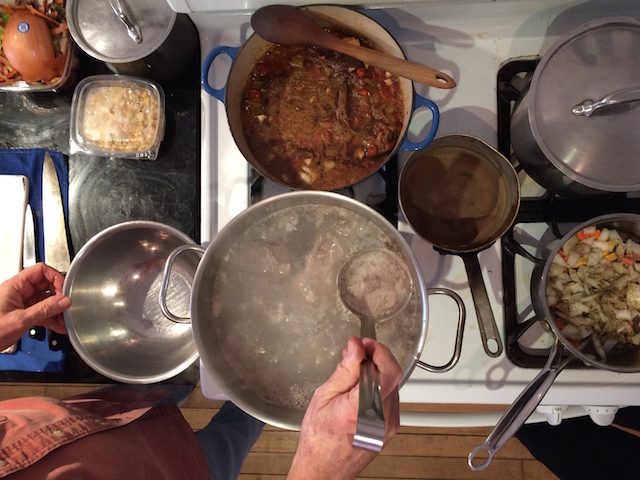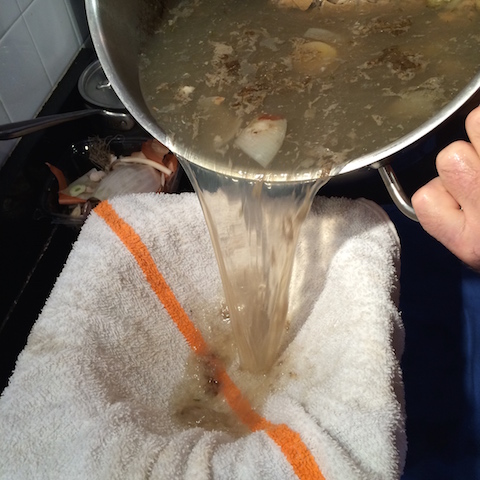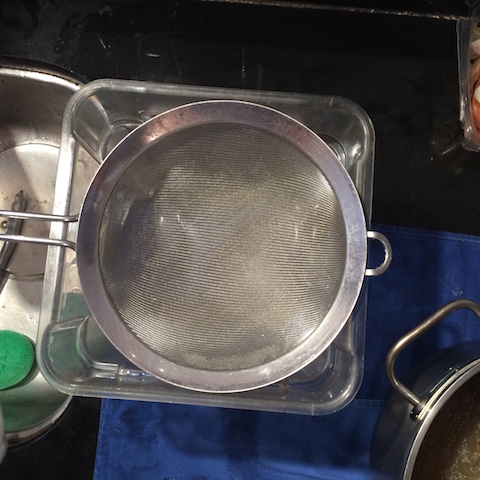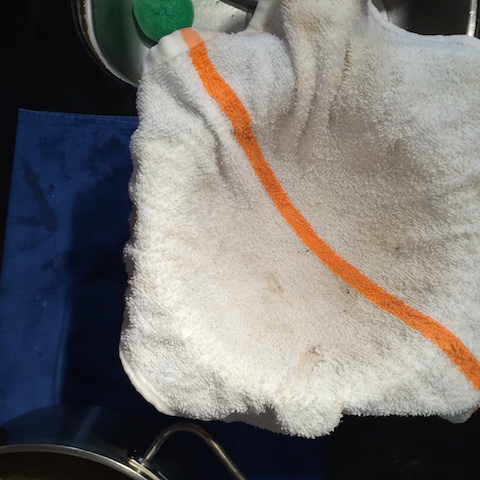Rich Winter Stock
Slow-cooked dinners are perfect for winter: a pot roast of beef, pork or lamb simmered in rich stock makes a meal that keeps on giving.
But to begin, one needs that deep, rich, full-flavored stock with complex flavors. Once you have created this foundation, the cooking takes little more than time and patience.
A note on the ingredients: to make approximately two gallons of stock you will need the following ingredients some of which may not be easy to find, but give Ohio City Provisions a call to see if they have it on-hand. They're listed below in order from "must have" to "optional."
Cover the bottom of a stock pot with olive oil. Set the pot over medium-high heat. Add all of the meat items except the pancetta and prosciutto. Using tongs or a large spoon turn the pieces over often. In addition to browning the bones and meat you want to build a dark brown—but not burned—coating on the bottom of the pan. Adjust the heat to prevent any burned spots on the bottom of the pot. This will take about a half hour. While they're cooking, peel, slice, chop and the rest of your ingredients.
When the bones are browned and a dark, caramel coats the bottom of the pan, add two or three cups of water. Scrape the bottom to release all the caramelized juices. The bottom of the pan should be nearly clean. When the water has nearly evaporated, just before the residue could burn, add another two or three cups of water and repeat the process once more.

Next, add the chopped vegetables, the pancetta and prosciutto (if using) and enough water to completely cover the bones by three or four inches. Bring the liquid to a boil and skim for several minutes. Lower the heat to medium and add the thyme and the bay leaf. The liquid should bubble—more than a simmer—but not reach a hard boil. Simmer the stock for four or five hours. Add more water if the level goes below the bones.
Let the stock cool for an hour or two before straining it through a strainer lined with a wet cloth.* Allow the stock to cool, and when it is almost room temperature put it in the fridge. You can save the bones and vegetables to ad more water and repeat the whole process for another batch.

The next day or within a couple of days, carefully remove the fat from the top of the stock. If the stock is thin and there are pieces of fat floating on top you can strain it again through a damp cloth. Return the stock to a heavy bottom pan and set over low heat. Do not boil the stock. Reduce the stock to concentrate the flavor. Allow to fully cool, then pour into small, labeled containers and freeze for later use.
Place a fine-mesh filter over a large bowl or container.

Get a terry-cloth towel wet, and drape it across top of strainer.

Make a little well, and you're ready to pour in the stock.

Ingredients
Directions
Cover the bottom of a stock pot with olive oil. Set the pot over medium-high heat. Add all of the meat items except the pancetta and prosciutto. Using tongs or a large spoon turn the pieces over often. In addition to browning the bones and meat you want to build a dark brown—but not burned—coating on the bottom of the pan. Adjust the heat to prevent any burned spots on the bottom of the pot. This will take about a half hour. While they're cooking, peel, slice, chop and the rest of your ingredients.
When the bones are browned and a dark, caramel coats the bottom of the pan, add two or three cups of water. Scrape the bottom to release all the caramelized juices. The bottom of the pan should be nearly clean. When the water has nearly evaporated, just before the residue could burn, add another two or three cups of water and repeat the process once more.

Next, add the chopped vegetables, the pancetta and prosciutto (if using) and enough water to completely cover the bones by three or four inches. Bring the liquid to a boil and skim for several minutes. Lower the heat to medium and add the thyme and the bay leaf. The liquid should bubble—more than a simmer—but not reach a hard boil. Simmer the stock for four or five hours. Add more water if the level goes below the bones.
Let the stock cool for an hour or two before straining it through a strainer lined with a wet cloth.* Allow the stock to cool, and when it is almost room temperature put it in the fridge. You can save the bones and vegetables to ad more water and repeat the whole process for another batch.

The next day or within a couple of days, carefully remove the fat from the top of the stock. If the stock is thin and there are pieces of fat floating on top you can strain it again through a damp cloth. Return the stock to a heavy bottom pan and set over low heat. Do not boil the stock. Reduce the stock to concentrate the flavor. Allow to fully cool, then pour into small, labeled containers and freeze for later use.
Place a fine-mesh filter over a large bowl or container.

Get a terry-cloth towel wet, and drape it across top of strainer.

Make a little well, and you're ready to pour in the stock.

